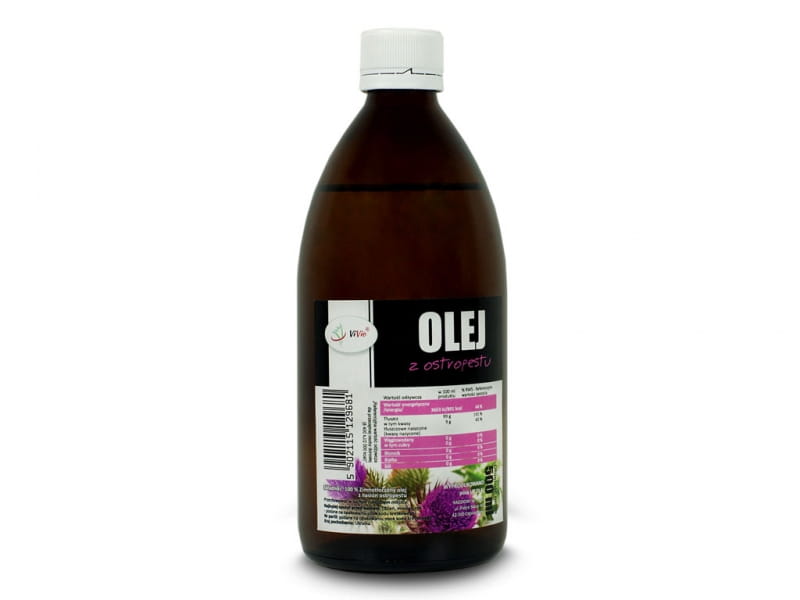Milk thistle oil, cold pressed 500ml - VIVIO
- Regular price
- €10,82
- Regular price
-
- Sale price
- €10,82
- Unit price
- per
Couldn't load pickup availability
Description
xThe milk thistle is also called milk thistle. It is easily recognized by its distinctive leaves covered with white spots. Legend has it that these spots were formed from drops of Mary's milk falling on the plant while baby Jesus was being fed.
The healing properties of milk thistle were discovered in ancient times. Mentions about him can already be found in the works of the Greek botanist Theophrastus of Eresos. Other ancient researchers have also pointed out a number of health benefits of using milk thistle. A comprehensive description of the effects of milk thistle can also be found in the notes of Hildegard von Bingen, a well-known healer.
Milk thistle attracts the attention of modern scientists mainly because of its impressive silymarin content. Today we know that the valuable properties of milk thistle preparations are due to this compound.
Unrefined milk thistle oil has a slightly bitter, nutty flavor and a yellow-brown color. It comes in dark glass bottles. It is mainly valued for the presence of silymarin, but it is not the only valuable ingredient in this product. Milk thistle oil is also a source of flavonoids, vitamin C, linoleic acid, phytosterols and tannins
INGREDIENTS
cold-pressed milk thistle seed oil.
NUTRITIONAL VALUE OF THE PRODUCT IN 100 g
Energy value - 3663 kJ / 891 kcal
Fat - 99 g
- including saturated fatty acids - 9 g
Carbohydrates - 0 g
- of which sugar - 0 g
Dietary fiber - 0 g
Protein - 0g
salt - 0 g
NET WEIGHT : 500 ml
INSTRUCTIONS FOR USE
Milk thistle oil is widely used. In the kitchen it is eaten cold, as an accompaniment to salads, sauces and dips.
RECOMMENDED STORAGE
It should be stored at room temperature, around 20 degrees Celsius.
similar products
- Regular price
- €10,82
- Regular price
-
- Sale price
- €10,82
- Unit price
- per
- Regular price
- €10,82
- Regular price
-
- Sale price
- €10,82
- Unit price
- per
- Regular price
- €10,82
- Regular price
-
- Sale price
- €10,82
- Unit price
- per
- Regular price
- €10,82
- Regular price
-
- Sale price
- €10,82
- Unit price
- per
- Regular price
- €10,82
- Regular price
-
- Sale price
- €10,82
- Unit price
- per
- Regular price
- €10,82
- Regular price
-
- Sale price
- €10,82
- Unit price
- per
- Regular price
- €10,82
- Regular price
-
- Sale price
- €10,82
- Unit price
- per
- Regular price
- €10,82
- Regular price
-
- Sale price
- €10,82
- Unit price
- per
- Regular price
- €10,82
- Regular price
-
- Sale price
- €10,82
- Unit price
- per
- Regular price
- €10,82
- Regular price
-
- Sale price
- €10,82
- Unit price
- per
Recently Viewed Products
- Regular price
- €10,82
- Regular price
-
- Sale price
- €10,82
- Unit price
- per
- Regular price
- €10,82
- Regular price
-
- Sale price
- €10,82
- Unit price
- per
- Regular price
- €10,82
- Regular price
-
- Sale price
- €10,82
- Unit price
- per
- Regular price
- €10,82
- Regular price
-
- Sale price
- €10,82
- Unit price
- per
- Regular price
- €10,82
- Regular price
-
- Sale price
- €10,82
- Unit price
- per
- Regular price
- €10,82
- Regular price
-
- Sale price
- €10,82
- Unit price
- per
- Regular price
- €10,82
- Regular price
-
- Sale price
- €10,82
- Unit price
- per
- Regular price
- €10,82
- Regular price
-
- Sale price
- €10,82
- Unit price
- per
- Regular price
- €10,82
- Regular price
-
- Sale price
- €10,82
- Unit price
- per
- Regular price
- €10,82
- Regular price
-
- Sale price
- €10,82
- Unit price
- per
- Choosing a selection results in a full page refresh.











